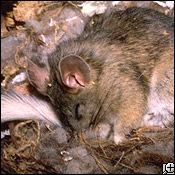Quck answer
The Bushy-Tailed Woodrat is a rodent native to North America, found in arid and semi-arid regions from southern Canada to northern Mexico. They are known for their unique ability to build large, complex nests made of sticks, leaves, and other materials. These nests can be several feet in diameter and are often used for shelter and food storage. Bushy-Tailed Woodrats are also important to their ecosystems as seed dispersers and prey for predators such as owls and foxes. However, they can sometimes be considered pests due to their habit of gnawing on wires and other materials in and around human dwellings.
Wild Animals

The Bushy-Tailed Woodrat, also known as the packrat, has a tendency to take shiny items to add to its collection of sticks, bones, and plants in its den. The dens, which are seven to nine feet in diameter, may be found on cliffs, rock slides, rocky outcroppings, caves, and canyons. A smaller nest is located inside the den. Bushy-tailed woodrats consume mainly green plants, twigs, nuts, and seeds. Some of the food is saved in the nest’s protective outer layer for later consumption. They are primarily terrestrial, but can climb trees up to fifty feet high. Spotted owls, bobcats, and weasels are some of the predators that prey on this species. When threatened, the woodrat creates a loud drumming noise by tapping its hind foot on the ground.
Animal Facts
Name: Bushy-Tailed Woodrat (Neotoma cinerea)
Family: Muridae (Rodents)
Range: Western United States and Canada
Habitat: Rocky areas in arctic alpine and arid regions
Diet: A variety of green and woody vegetation, as well as insects
Head and Body Length: 7 to 9 inches (17 to 24 cm)
Tail Length: 5 to 9 inches (12 to 24 cm)
Weight: 7 to 21 ounces (200 to 600 g)
Life Cycle: Gestation about 35 days, two to six young born in spring or summer
Description: Peppery brown coat; pale fur underneath; sharp claws; bushy, squirrel-like tail
Conservation Status: Common
Related Content: Corwin’s Carnival — Lil’ Mammals
FAQ
1. What is a Bushy-Tailed Woodrat?
A Bushy-Tailed Woodrat is a small rodent that is native to North America. It is also known as a pack rat because of its habit of collecting and storing objects.
2. Where do Bushy-Tailed Woodrats live?
Bushy-Tailed Woodrats can be found throughout the western United States, from California to Texas. They prefer to live in desert and mountainous regions.
3. What do Bushy-Tailed Woodrats eat?
Bushy-Tailed Woodrats are omnivores, which means they eat both plants and animals. Their diet consists of seeds, fruits, insects, and small animals.
4. How do Bushy-Tailed Woodrats build their nests?
Bushy-Tailed Woodrats build complex nests out of sticks, leaves, and other natural materials. They often use cactus spines and other sharp objects to deter predators.
5. Are Bushy-Tailed Woodrats social animals?
Yes, Bushy-Tailed Woodrats are social animals and often live in family groups. They communicate with each other using a variety of vocalizations and scent markings.
6. How long do Bushy-Tailed Woodrats live?
Bushy-Tailed Woodrats have a lifespan of about 2-3 years in the wild.
7. What predators do Bushy-Tailed Woodrats have?
Bushy-Tailed Woodrats are preyed upon by a variety of animals, including hawks, owls, coyotes, and snakes.
8. How do Bushy-Tailed Woodrats defend themselves?
Bushy-Tailed Woodrats have several defense mechanisms, including building complex nests with sharp objects, hiding in crevices and burrows, and emitting a musky odor to deter predators.
9. Are Bushy-Tailed Woodrats endangered?
No, Bushy-Tailed Woodrats are not currently considered endangered. However, habitat loss and fragmentation are potential threats to their populations.
10. Can Bushy-Tailed Woodrats be kept as pets?
No, it is illegal to keep Bushy-Tailed Woodrats as pets without a special permit.
11. What is the scientific name for Bushy-Tailed Woodrat?
The scientific name for Bushy-Tailed Woodrat is Neotoma cinerea.





Leave a Reply